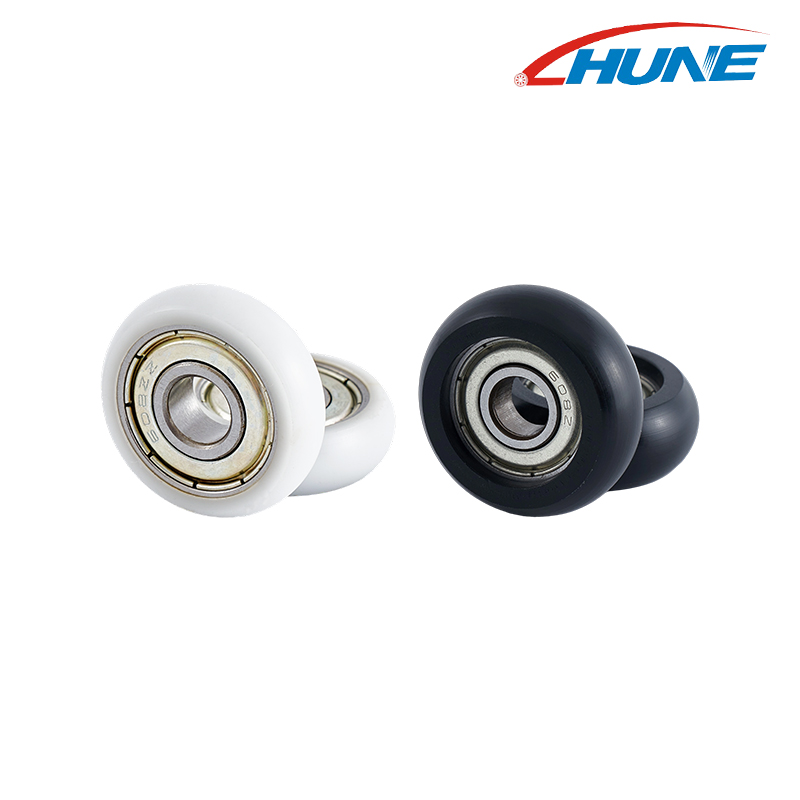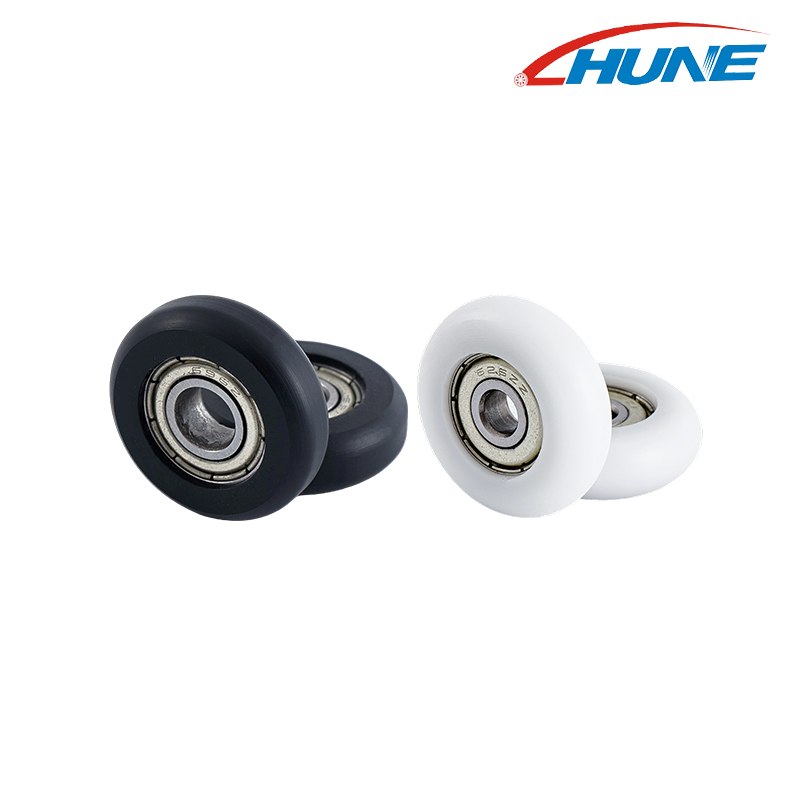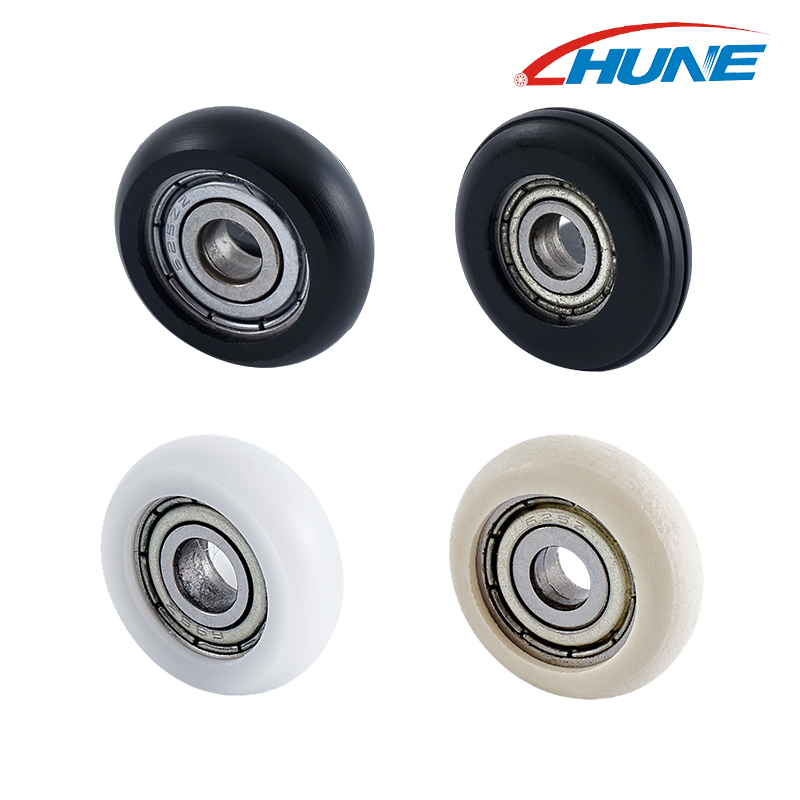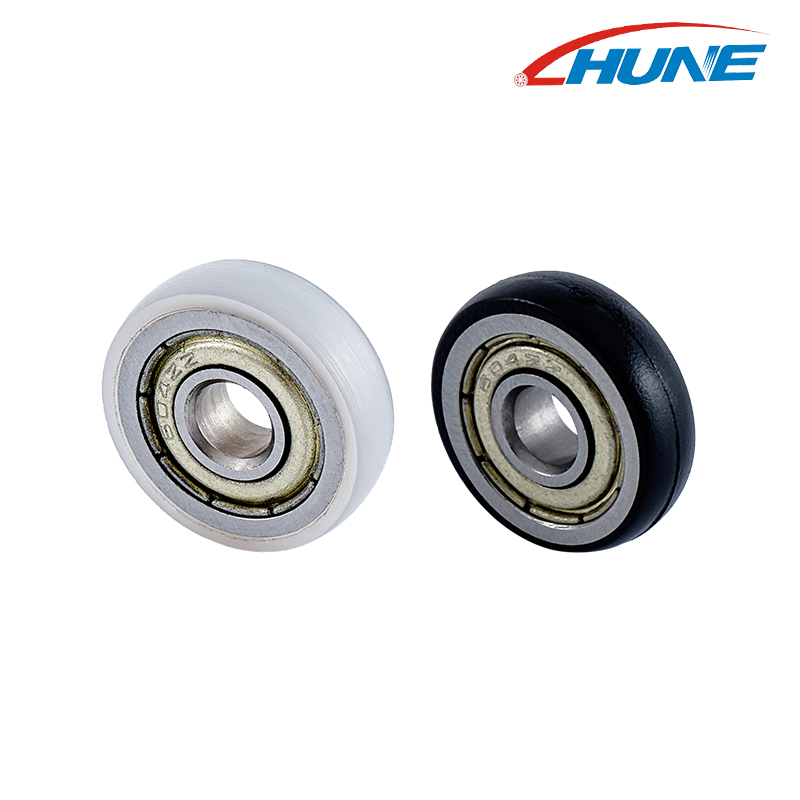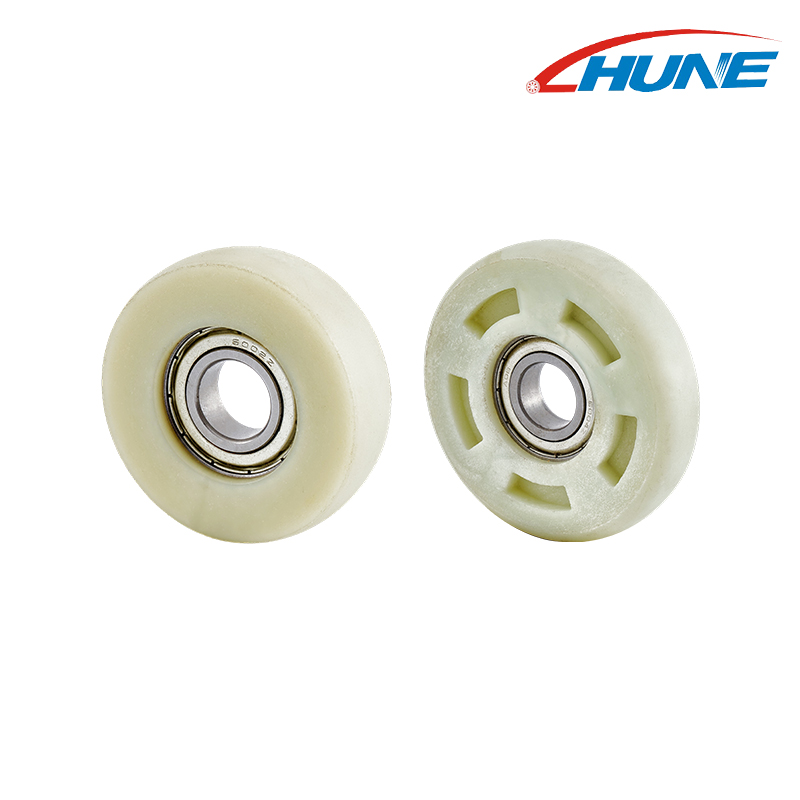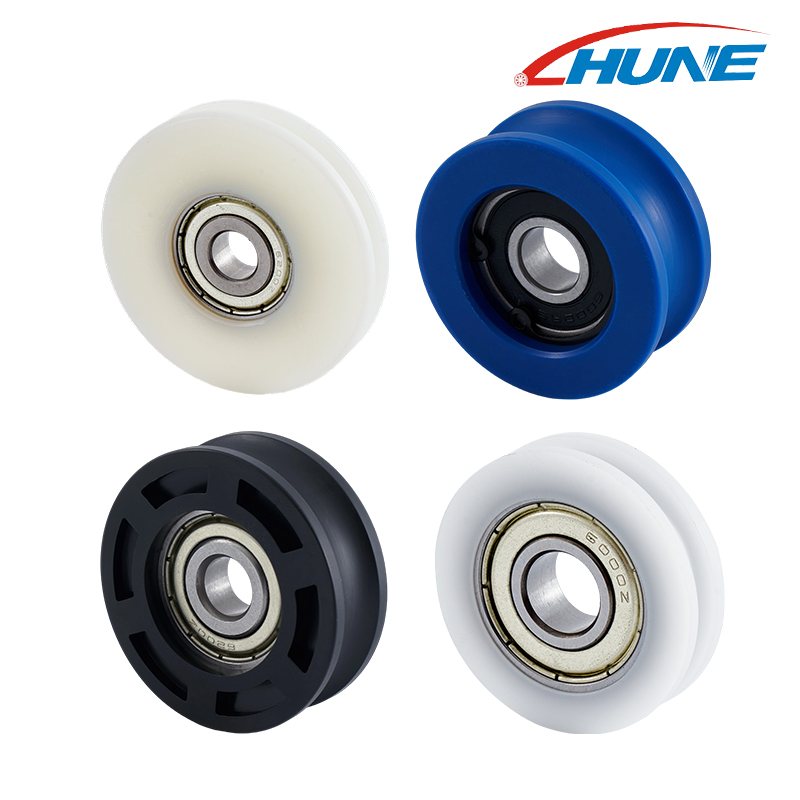U-Type Groove Pulleys are vital components in conveyor systems, ensuring smooth and efficient operation by maintaining proper belt alignment and tension. These pulleys feature a distinct "U" shaped groove that securely holds the belt in place, preventing it from slipping off during operation. This groove design allows the pulley to support the belt more effectively than traditional flat pulleys, which can lead to misalignment and premature belt wear.
In conveyor systems, the role of U-Type Groove Pulleys extends beyond just belt guidance; they help to optimize power transmission and reduce friction. This translates into a more efficient conveyor system, where energy consumption is minimized, and the life of both the pulleys and belts is significantly extended. U-type groove pulleys are particularly valuable in high-load or high-speed applications where maintaining tension and alignment is critical for performance.
By ensuring the belt remains aligned and operating under the correct tension, U-Type Groove Pulleys also reduce the need for frequent maintenance, which can lead to reduced downtime and enhanced system reliability. These benefits make them indispensable for industries such as manufacturing, material handling, mining, and agriculture, where large-scale and high-volume conveyor systems are commonly used.
What is a U-Type Groove Pulley?
A U-Type Groove Pulley is a specialized type of pulley designed with a "U" shaped groove along its circumference. This groove is specifically engineered to securely house V-belts or other types of belts, preventing them from slipping or misaligning during operation. The U-shaped groove helps maintain consistent belt positioning, which is crucial for ensuring smooth and efficient operation in machinery and conveyor systems.
Materials Used in U-Type Groove Pulleys: Which One is Right for You?
When choosing a U-Type Groove Pulley for industrial applications, one of the most critical decisions is selecting the right material. The material used for the pulley directly impacts its performance, durability, and suitability for specific environments. U-type groove pulleys are made from various materials, each offering distinct advantages depending on the application.
1. Steel Pulleys
Overview:
Steel is one of the most widely used materials for U-type groove pulleys due to its strength, durability, and versatility. Steel pulleys are capable of handling heavy loads and are ideal for high-torque applications.
Advantages:
High Load Capacity: Steel pulleys are designed to withstand significant mechanical stress and are well-suited for heavy-duty applications.
Durability: Steel has excellent wear resistance and can withstand harsh conditions, including high temperatures and exposure to chemicals.
Corrosion Resistance: Stainless steel variants offer excellent corrosion resistance, making them suitable for outdoor or marine environments.
Applications:
Steel U-type groove pulleys are typically used in conveyor systems, mining, construction, and manufacturing sectors, where high load-bearing capacity and durability are required.
2. Cast Iron Pulleys
Overview:
Cast iron is another popular material for U-type groove pulleys, particularly in applications where durability is a priority. Cast iron pulleys are known for their strength and ability to absorb vibrations, making them a good choice for systems that experience high shock loads.
Advantages:
Strength and Stability: Cast iron is known for its ability to handle heavy loads while maintaining stability under pressure.
Vibration Dampening: Cast iron's density helps reduce vibrations, making it ideal for applications requiring smooth operation.
Cost-Effective: Compared to steel, cast iron is generally more affordable, making it a cost-effective choice for many industrial applications.
Applications:
Cast iron U-type groove pulleys are commonly used in industrial machinery, HVAC systems, and large-scale conveyor systems.
3. Aluminum Pulleys
Overview:
Aluminum U-type groove pulleys are lightweight yet durable, making them a popular choice for applications that require reduced weight without compromising strength.
Advantages:
Lightweight: Aluminum's low density makes it ideal for applications where weight is a concern, such as in aerospace or automotive industries.
Corrosion Resistance: Aluminum is naturally resistant to corrosion, making it perfect for outdoor or marine environments.
Good Strength-to-Weight Ratio: While lighter than steel or cast iron, aluminum still provides substantial strength and durability.
Applications:
Aluminum U-type groove pulleys are commonly used in lightweight machinery, automotive systems, and small conveyor systems where weight reduction is a priority.
4. Plastic and Nylon Pulleys
Overview:
For applications that require a non-metallic, corrosion-resistant solution, plastic and nylon U-type groove pulleys are often used. These materials are particularly suited for lightweight, low-load applications where noise reduction and ease of installation are critical.
Advantages:
Corrosion Resistance: Plastic and nylon pulleys are highly resistant to corrosion, making them ideal for use in wet or chemically aggressive environments.
Low Maintenance: These materials require less maintenance than metal counterparts, as they do not corrode or rust.
Noise Reduction: Plastic and nylon pulleys help minimize noise and vibrations in systems, making them ideal for quieter environments.
Applications:
Plastic and nylon U-type groove pulleys are ideal for light-duty applications, such as in food processing, pharmaceutical machinery, and clean room environments where corrosion and noise are concerns.
5. Composite Materials
Overview:
Composite U-type groove pulleys are made from a combination of materials such as carbon fiber or fiberglass, providing an excellent balance of strength, durability, and lightweight properties.
Advantages:
High Strength-to-Weight Ratio: Composite materials offer a superior balance of strength and lightness.
Corrosion Resistance: Composites are naturally resistant to chemicals and corrosion, making them suitable for harsh environments.
Customizability: Composites can be engineered for specific performance characteristics, such as enhanced flexibility or thermal resistance.
Applications:
Composite U-type groove pulleys are often used in specialized applications such as aerospace, high-performance machinery, and environments where extreme conditions are present.
| Material | Overview | Advantages | Applications |
|---|---|---|---|
| Steel Pulleys | Widely used for high-strength applications. | - High load capacity - Durable and resistant to wear - Corrosion-resistant (stainless steel) |
Conveyor systems, mining, construction, manufacturing, and heavy-duty industrial applications |
| Cast Iron Pulleys | Known for strength and vibration dampening. | - Strong and stable under heavy loads - Absorbs vibrations - Cost-effective |
Industrial machinery, HVAC systems, large-scale conveyor systems |
| Aluminum Pulleys | Lightweight and corrosion-resistant. | - Lightweight - Corrosion-resistant - Good strength-to-weight ratio |
Aerospace, automotive, small conveyor systems, lightweight machinery |
| Plastic & Nylon Pulleys | Non-metallic, corrosion-resistant materials. | - Corrosion-resistant - Low maintenance - Reduces noise and vibrations |
Food processing, pharmaceutical machinery, clean room environments, low-load applications |
| Composite Materials | Combination of materials like carbon fiber or fiberglass. | - High strength-to-weight ratio - Corrosion-resistant - Customizable performance |
Aerospace, high-performance machinery, extreme environments |
Which Material is Right for Your Application?
Choosing the right material for your U-Type Groove Pulley depends on several factors, including:
Load Capacity: For high-load applications, steel or cast iron is generally preferred due to their strength and durability.
Environment: If your pulley will be exposed to harsh chemicals, moisture, or extreme temperatures, materials like stainless steel, aluminum, or plastic may be the best options.
Weight Considerations: For applications where weight is a critical factor, such as in automotive or aerospace industries, aluminum or composite materials are ideal choices.
Corrosion Resistance: If the pulley will be exposed to corrosive environments, stainless steel, aluminum, or plastic materials provide excellent resistance.
Cost: Cast iron and plastic offer more cost-effective solutions for lower-load or less demanding applications.
By understanding the unique properties of each material, you can make a more informed decision about which U-Type Groove Pulley material best meets your operational and performance needs.
What are the Advantages of Using U-Type Groove Pulleys?
1. Improved Belt Alignment and Stability
The U-shaped groove design ensures that the belt stays securely in place, preventing it from slipping off or misaligning during operation. This stable alignment helps maintain the proper tension in the belt, ensuring consistent performance across various applications. By minimizing misalignment, U-type groove pulleys reduce the likelihood of belt failure, thereby increasing the lifespan of both the pulley and the belt.
2. Enhanced Efficiency and Power Transmission
U-type groove pulleys are designed to optimize power transmission by maintaining consistent tension in the belt. This efficient transfer of energy reduces friction and wear on both the belt and the pulley. As a result, machinery operates more smoothly, consuming less energy and requiring less maintenance. The increased efficiency helps to lower operational costs and improve overall productivity.
3. Reduced Belt Wear
The groove design helps to evenly distribute the tension along the length of the belt, reducing localized wear that typically occurs with flat pulleys. By minimizing friction and preventing belt slippage, U-type groove pulleys prolong the life of the belt. This leads to fewer replacements, lower maintenance costs, and enhanced system longevity.
4. Noise and Vibration Reduction
The U-shaped groove helps to stabilize the belt during operation, which in turn reduces vibrations and noise. This is especially beneficial in environments where noise control is important, such as in residential or commercial settings, or in applications where machinery operates at high speeds or under heavy loads.
5. Versatility Across Multiple Applications
U-type groove pulleys are versatile and can be used in a variety of mechanical systems. Whether for low-load, high-speed applications or heavy-duty operations, there is a U-type groove pulley suited to the task. These pulleys are adaptable to different belt types, such as V-belts and flat belts, making them suitable for a wide range of machinery.
6. Reduced Maintenance and Downtime
By maintaining proper belt alignment and reducing wear, U-type groove pulleys minimize the need for frequent maintenance. The consistent operation of machinery leads to less downtime, allowing systems to operate more reliably and cost-effectively. This is particularly important in industrial settings where downtime can be costly and disrupt production schedules.
| Advantage | Description |
|---|---|
| Improved Belt Alignment and Stability | The U-shaped groove ensures secure belt placement, preventing misalignment and slippage. Maintains proper tension for consistent performance. |
| Enhanced Efficiency and Power Transmission | Optimizes energy transfer by reducing friction, allowing machinery to run more smoothly with lower energy consumption and less wear. |
| Reduced Belt Wear | Evenly distributes tension along the belt, reducing localized wear and tear, and extending the lifespan of both the pulley and the belt. |
| Noise and Vibration Reduction | Stabilizes the belt, minimizing vibrations and noise, ideal for environments where noise control is important or where heavy loads are involved. |
| Versatility Across Multiple Applications | Can be used in various applications, such as low-load and high-speed systems, as well as heavy-duty machinery, accommodating different belt types. |
| Reduced Maintenance and Downtime | By maintaining proper alignment and reducing wear, U-type groove pulleys lower maintenance requirements and minimize downtime, leading to cost savings. |
In Which Industries are U-Type Groove Pulleys Used?
U-Type Groove Pulleys are essential components in a variety of industries, thanks to their ability to optimize belt performance, reduce wear, and increase efficiency.
1. Manufacturing Industry
In manufacturing, conveyor systems are critical for transporting materials and finished goods across production lines. U-type groove pulleys are widely used in these systems to maintain belt alignment and ensure smooth, uninterrupted operation. Their ability to handle high loads and improve power transmission makes them indispensable in industries such as automotive, electronics, and consumer goods manufacturing.
2. Mining and Heavy Industry
U-type groove pulleys play a crucial role in mining and heavy industries, where conveyor systems are used to transport raw materials, minerals, and heavy loads. These pulleys are designed to withstand high stress, heavy loads, and challenging environmental conditions, making them ideal for applications in mining, steel production, and construction.
3. Agriculture and Food Processing
In agriculture and food processing, U-type groove pulleys are used in machinery that handles crops, packaging, and processing lines. These industries benefit from the enhanced belt stability and reduced wear provided by U-type groove pulleys, ensuring that equipment operates efficiently and with minimal maintenance.
4. Automotive Industry
U-type groove pulleys are commonly used in automotive manufacturing for power transmission systems, such as in engines and accessory drives. The U-shaped groove provides secure alignment for belts that drive critical components like alternators, water pumps, and air conditioning units. Their reliable performance helps reduce maintenance and improve the overall efficiency of automotive systems.
5. HVAC (Heating, Ventilation, and Air Conditioning)
In HVAC systems, U-type groove pulleys are used in ventilation fans, air handling units, and other mechanical systems. The U-shaped groove helps ensure smooth operation and reduces noise, which is crucial in maintaining the comfort and efficiency of climate control systems in both residential and commercial buildings.
6. Material Handling
Material handling applications, such as those found in warehouses and logistics centers, rely heavily on conveyor systems to move products efficiently. U-type groove pulleys are ideal for these systems, as they help prevent belt misalignment and ensure smooth, continuous operation in environments where speed and reliability are paramount.
7. Renewable Energy (Wind and Solar)
In the renewable energy sector, U-type groove pulleys are used in machinery for the production, installation, and maintenance of wind turbines and solar panels. Their ability to handle varying load conditions and reduce wear makes them an excellent choice for such dynamic environments, where reliability and durability are key.
8. Packaging and Printing
The packaging and printing industries rely on conveyor systems to move products through various stages of production and packaging. U-type groove pulleys are widely used in these systems to maintain smooth and efficient movement of materials, reducing downtime and improving productivity.
9. Aerospace and Aviation
In the aerospace industry, U-type groove pulleys are used in applications such as aircraft engine systems, landing gear operations, and other critical power transmission systems. Their high load-bearing capacity and precision make them ideal for aerospace applications, where reliability and performance are essential.
Industries Where U-Type Groove Pulleys are Used
| Industry | Description |
|---|---|
| Manufacturing Industry | Used in conveyor systems for material transportation in sectors like automotive, electronics, and consumer goods manufacturing. |
| Mining and Heavy Industry | Vital for high-stress applications such as transporting raw materials in mining, steel production, and construction, where durability is essential. |
| Agriculture and Food Processing | Used in agricultural machinery and food processing lines to ensure efficient, continuous operation with minimal maintenance. |
| Automotive Industry | Found in automotive engines and accessory drive systems, ensuring smooth belt operation for components like alternators and water pumps. |
| HVAC (Heating, Ventilation, and Air Conditioning) | Essential in HVAC systems to power fans and air handling units, reducing noise and enhancing system performance in residential and commercial buildings. |
| Material Handling | In warehouses and logistics centers, used in conveyor systems to transport goods efficiently, ensuring smooth and reliable operation. |
| Renewable Energy (Wind and Solar) | Used in the production, installation, and maintenance of wind turbines and solar panels, where durability and reliability are critical. |
| Packaging and Printing | Applied in packaging and printing industries to ensure smooth product movement through production and packaging lines, increasing productivity. |
| Aerospace and Aviation | Used in aircraft systems such as engine mechanisms and landing gear, where precision and high load-bearing capacity are required for reliability and safety. |
How Do U-Type Groove Pulleys Reduce Belt Wear?
1. Proper Belt Alignment
One of the primary causes of belt wear is misalignment, which can lead to uneven tension and friction on the belt. The U-shaped groove helps maintain the belt's proper alignment along the pulley, preventing it from wandering off track. By ensuring that the belt stays centered, U-Type Groove Pulleys reduce the stress on the edges of the belt, minimizing the risk of premature wear or fraying.
2. Even Distribution of Tension
The U-shaped groove not only keeps the belt aligned but also helps distribute the tension evenly along the length of the belt. This even distribution prevents localized pressure points, which are a common cause of excessive wear. As the tension is spread out more uniformly, the belt experiences less friction, which extends its lifespan and reduces the frequency of maintenance or replacement.
3. Minimizing Slippage
Belt slippage occurs when the belt is not in full contact with the pulley surface, causing friction and heat buildup. The U-shaped groove ensures that the belt remains firmly engaged with the pulley, reducing the likelihood of slippage. By preventing the belt from slipping off or sliding, the pulley reduces the amount of friction that causes wear and tear over time.
4. Reducing Vibration and Shock
Belt systems that experience excessive vibrations or shock loading often lead to uneven wear patterns on the belt. The U-Type Groove Pulley helps stabilize the belt's movement, reducing vibrations and absorbing shock loads. By providing a stable environment for the belt to move within, the pulley prevents sudden jerks or shifts that would otherwise accelerate wear.
5. Enhanced Friction Control
The U-shaped groove improves friction control by keeping the belt in constant contact with the pulley surface in a stable manner. This reduces the sliding friction that often occurs with other types of pulleys. By optimizing the friction levels, the U-type groove pulley helps the belt move smoothly, reducing the heat buildup that can lead to degradation and eventual wear.
U-Type Groove Pulleys vs Standard Pulleys: Which Is Better?
When selecting pulleys for a mechanical system, it's essential to understand the differences between U-Type Groove Pulleys and Standard Pulleys. While both types of pulleys serve the same fundamental purpose—guiding a belt and ensuring power transmission—their design and functionality differ significantly, with each having its advantages depending on the application.
1. Design and Functionality
U-Type Groove Pulleys:
U-Type Groove Pulleys are designed with a U-shaped groove that holds the belt securely in place, ensuring that it remains centered and aligned during operation. This design helps to prevent slippage and misalignment, making it ideal for systems where belt stability is a priority. The U-shape also helps to distribute tension evenly across the belt, minimizing the wear and tear that can occur with other types of pulleys.
Standard Pulleys:
Standard pulleys, often flat or V-shaped, do not offer the same level of belt support as U-type pulleys. Without a groove to guide the belt, standard pulleys rely on belt tension to keep the belt in place, which can lead to misalignment, especially under heavy loads or high speeds. This can result in uneven wear and reduced system efficiency.
2. Belt Stability and Alignment
U-Type Groove Pulleys:
The U-shaped groove of U-type pulleys ensures superior belt alignment and stability. It prevents the belt from drifting off-center, even when exposed to variable load conditions. This is particularly important in high-speed or high-load applications where precision is critical.
Standard Pulleys:
Standard pulleys, particularly flat pulleys, are prone to belt misalignment, especially when there is a sudden shift in load. Misalignment can cause the belt to slip or wear unevenly, leading to increased maintenance needs and premature failure.
3. Load Handling and Durability
U-Type Groove Pulleys:
U-type pulleys excel in handling heavy loads due to their superior design, which evenly distributes the tension across the belt. This makes them ideal for demanding applications, such as in industrial machinery, mining, or material handling systems. The sturdy groove also ensures that the pulley can withstand high torque and load without failure.
Standard Pulleys:
Standard pulleys, while versatile, may not handle heavy loads as effectively as U-type groove pulleys. Without the groove to help distribute tension, standard pulleys can wear out faster when subjected to high-stress conditions. This can lead to reduced efficiency and more frequent replacements.
4. Maintenance and Longevity
U-Type Groove Pulleys:
U-type pulleys are designed to reduce belt wear by maintaining proper alignment, preventing slippage, and evenly distributing tension. These features lead to lower maintenance requirements, as the pulleys help extend the life of both the belt and the pulley itself. Systems with U-type groove pulleys tend to experience less downtime, increasing operational efficiency.
Standard Pulleys:
Standard pulleys may require more frequent maintenance due to their tendency to cause belt misalignment and wear. The absence of a groove means that belts are more likely to experience uneven tension, resulting in faster wear and more frequent replacements. Consequently, systems with standard pulleys may experience more downtime and higher long-term maintenance costs.
5. Applications
U-Type Groove Pulleys:
Ideal for applications that require precise belt alignment and stability, such as high-load industrial systems, material handling, automotive systems, and heavy-duty conveyors. They are also well-suited for high-speed machinery where minimizing wear and reducing maintenance are top priorities.
Standard Pulleys:
Standard pulleys are more commonly used in light-duty applications, such as in household machinery, small-scale conveyor systems, and some automotive applications. They are more cost-effective in low-load and low-speed environments but are less suitable for applications requiring high performance and reliability.
U-Type Groove Pulleys vs Standard Pulleys: Which Is Better?
| Feature | U-Type Groove Pulleys | Standard Pulleys |
|---|---|---|
| Design and Functionality | U-shaped groove that holds the belt securely in place, maintaining alignment and distributing tension. | Flat or V-shaped design, relying on tension to keep the belt in place, leading to potential misalignment. |
| Belt Stability and Alignment | Ensures superior belt alignment, preventing misalignment and slippage. | Prone to belt misalignment, especially under high loads or variable conditions. |
| Load Handling and Durability | Handles heavy loads efficiently by evenly distributing tension, ideal for demanding applications. | May struggle with heavy loads, leading to faster wear and reduced durability. |
| Maintenance and Longevity | Reduces belt wear and maintenance by maintaining alignment and tension, lowering downtime. | May require more frequent maintenance due to belt misalignment, leading to increased wear. |
| Applications | Best for high-load, high-speed, and industrial applications where precision and stability are critical. | Suitable for light-duty applications, lower cost, and less demanding environments. |
How to Choose the Right U-Type Groove Pulley for Your Industrial Applications
Selecting the right U-Type Groove Pulley for your industrial application is critical to ensuring optimal performance, longevity, and system efficiency.
1. Belt Type and Size
The type and size of the belt you are using is one of the most important considerations when selecting a U-type groove pulley. Different pulleys are designed to accommodate various belt types, such as V-belts, flat belts, and timing belts. Ensure that the pulley's groove profile matches the belt's specifications, including the correct width, diameter, and depth. Using the wrong size or shape of the pulley could lead to belt misalignment, premature wear, and increased maintenance costs.
V-Belts: Ensure the pulley has the correct V-groove shape and dimensions for proper fitment.
Flat Belts: Look for pulleys designed with a flat, wide groove that holds the belt firmly.
Timing Belts: Choose pulleys that specifically accommodate the tooth profile of timing belts.
2. Load Capacity
U-Type Groove Pulleys come in various designs to handle different load capacities. It's essential to choose a pulley that can withstand the weight and stress generated by the application. Heavy-duty applications such as material handling, mining, or manufacturing require pulleys made of robust materials like steel or cast iron to support high loads.
Light-duty applications may use aluminum or plastic pulleys.
Heavy-duty applications require steel or cast iron pulleys for maximum strength and durability.
3. Material Compatibility
Choosing the right material for your U-type groove pulley depends on the operating environment and the type of application. Common materials include:
Steel: Best for high-load, heavy-duty applications where strength and durability are required.
Stainless Steel: Ideal for corrosive or high-temperature environments.
Cast Iron: Good for vibration dampening and handling heavy loads.
Aluminum: Best for lightweight, non-corrosive applications.
Plastic/Nylon: Suitable for low-load, corrosion-resistant applications in clean environments.
Ensure that the pulley material is compatible with the environmental conditions, such as exposure to moisture, temperature fluctuations, chemicals, or abrasives.
4. Pulley Diameter and Speed
The diameter of the pulley is critical in determining the speed at which the belt operates. Choose a pulley diameter that aligns with the system's required speed and the intended load. Larger pulleys are generally suited for low-speed, high-torque applications, while smaller pulleys are suitable for high-speed systems.
5. Environment and Conditions
Consider the operating environment where the U-type groove pulley will be used. If the pulley is exposed to extreme temperatures, chemicals, or moisture, it's important to choose a material that can withstand such conditions. For outdoor applications or systems exposed to harsh weather conditions, stainless steel or aluminum pulleys may be ideal due to their corrosion resistance.
6. Groove Design
The groove design of the U-type pulley can vary, including deep or shallow grooves. For precision and stability, ensure that the groove depth aligns with the specifications of the belt. The groove profile should securely hold the belt to prevent slippage and reduce wear.
Deep Grooves: Typically used for larger belts or systems requiring higher torque.
Shallow Grooves: Suitable for systems with lighter loads or smaller belts.
7. Pulley Alignment and Positioning
Proper pulley alignment is essential for minimizing friction, reducing wear, and ensuring smooth operation. It's crucial to align the pulley with the rest of the system to prevent unnecessary tension or strain on the belt.
Pulley Alignment: Proper installation and alignment are key to maximizing performance and reducing system failures.
How to Maintain U-Type Groove Pulleys?
To ensure the longevity and optimal performance of U-Type Groove Pulleys, regular maintenance is essential. Proper care will reduce wear, increase efficiency, and minimize the frequency of replacements.
1. Regular Inspections
Routine inspections are vital for identifying potential issues before they lead to system failure. During inspections, look for signs of:
Belt misalignment: Ensure the belt is securely in place within the U-shaped groove.
Excessive wear: Check for signs of wear on the pulley's groove surface or belt.
Cracks or damage: Examine the pulley for any physical damage, especially in the groove or mounting area.
2. Lubrication
While U-type groove pulleys often operate without lubrication, some systems may benefit from periodic lubrication to reduce friction. Use the appropriate lubricant recommended by the pulley manufacturer to avoid damage to the pulley material or belt. Excessive lubrication can lead to dirt buildup, which may cause more wear and tear.
3. Cleaning and Debris Removal
Keeping the pulley and belt free from debris, dirt, and other contaminants is essential for smooth operation. Clean the pulley and surrounding areas regularly using compressed air or a soft brush to remove any buildup. Excessive dirt or grime can cause premature wear on the pulley and belt, affecting system performance.
4. Monitoring Belt Tension
Ensure that the belt tension is maintained at the correct level, as both excessive and insufficient tension can cause wear on the pulley and belt. Regularly check the tension and adjust it as needed to ensure optimal performance. Proper tension helps prevent slippage, reduces belt wear, and ensures the system runs efficiently.
5. Check Pulley Alignment
Misalignment can cause uneven wear on both the pulley and the belt. Check that the pulley is correctly aligned with other system components, and make adjustments as necessary. Misalignment can lead to uneven load distribution, increased friction, and accelerated wear on the components.
6. Monitor Operating Environment
If your pulley operates in a harsh environment, such as extreme temperatures or exposure to chemicals, you may need to inspect it more frequently. Consider installing protective covers or shields to minimize the effects of harsh conditions and ensure the pulley continues to perform optimally.
7. Replace Worn Components
Over time, even with proper maintenance, pulleys may experience wear, especially in the groove area. If significant wear is observed on the groove or pulley surface, replace the pulley to avoid further damage to the belt and other components. Additionally, ensure the belt is replaced when it shows signs of excessive wear.
U-Type Groove Pulleys are essential components for optimizing the performance, longevity, and efficiency of conveyor systems. By ensuring proper belt alignment, reducing wear, and enhancing overall stability, these pulleys offer significant advantages in both heavy-duty and light-duty applications. With the right choice of material, such as steel, aluminum, or plastic, U-Type Groove Pulleys can withstand various operational challenges and environmental conditions, ensuring reliable and consistent performance. Regular maintenance, including proper inspections, lubrication, and alignment checks, is crucial to maximizing their lifespan and preventing unexpected downtime.
At HunePulley, we specialize in the production of a wide range of products, including miniature bearings, medium-sized bearings, non-standard customized bearings, hardware pulleys, injection molding pulleys, and hanging pulleys. Our products are widely used across various industries, including home appliances, doors and windows, and mechanical equipment. Whether you're looking for highly specialized or standard components, our expertise and commitment to quality ensure that we meet the diverse needs of our clients.
By choosing HunePulley for your pulley and bearing needs, you gain access to high-performance, durable products that are built to last, providing you with reliable solutions for all your mechanical and conveyor system requirements.






 English
English  Español
Español  日本語
日本語 